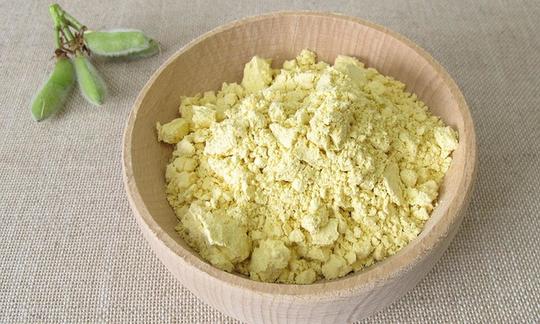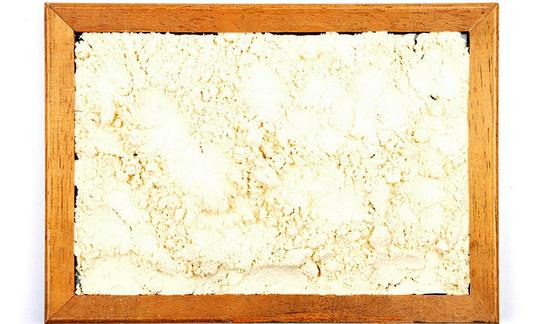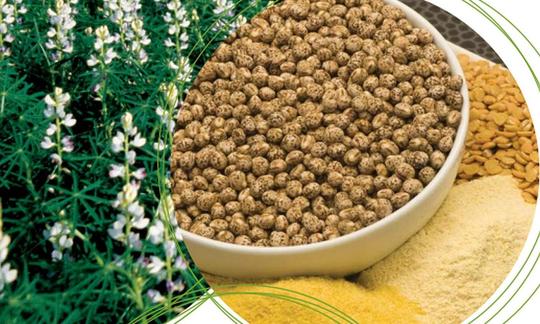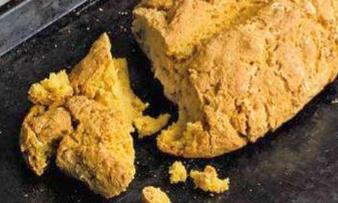Table of contents
For the production of lupin flour or lupin protein ( lupin protein ), the seeds of the cultivated and therefore non-toxic sweet lupin are used, mostly those of the white lupin ( Lupinus albus ).
Use in the kitchen
What is lupin flour? Lupin flour is made from the seeds of the lupin plant. It is rich in protein andfiber and is gluten-free, making it a good alternative to wheat flour. 24
What does lupin flour taste like? Lupin flour has a bitter, nutty and slightly sweet taste, but this is often not noticeable when used as an ingredient in cooking and baking. 1
What can you make from lupin flour? Lupin flour is most commonly used as a substitute for wheat flour, for example, when baking. As a guideline, you should replace a maximum of 15-20% of conventional flour with lupin flour. This way you can easily increase the protein content of cakes, muffins, pancakes, etc. and the baked goods taste lighter, airier and also have a yellowish color - even without eggs. 24
If you want to use lupin flour as a vegan egg substitute for patties, for example, it is worth adding a little starch (e.g. potato starch, corn starch ). Since lupin flour contains hardly any starch, it is not suitable for thickening sauces or soups. To replace an egg (vegan alternative), take around 15 g lupin flour and 45 ml water or a plant-based drink. You can also use this mixture as an egg substitute for a breading and then roll the product in breadcrumbs.
Due to the high protein content (approx. 38%) 4, lupin flour can also be mixed into protein drinks (protein-rich drinks).
In the Mediterranean region, pickled lupin seeds are known as a snack or delicacy in markets or inns (Italian: lupini, Spanish: altramuces or chochos).
By roasting the fruit, you can also make a coffee-like drink. Altreier coffee, for example, consists of roasted lupine seeds that are ground and poured over with hot water. 17
The food industry uses lupin flour (and the protein concentrate) not only for vegan products (tofu, spreads, pasta, baked goods, liquid seasoning), but also adds it to sausage products. It also has a high water-binding capacity, which means that baked goods do not dry out as quickly and have a longer shelf life. 24,26 The lecithin contained in lupin flour acts as an emulsifier: the ingredients combine better. In the supermarket you can also find vegan "cheese" that contains lupin flour. Lupin tofu, a tofu-like product made from lupin flour, is also a particularly tasty source of protein. 2 The product marketed as "Lopino" is no longer available. For vegan diets and products suitable for them, however, pure lupin protein (lupin protein isolate) is usually used to make milk substitutes such as yogurt, cheese or ice cream; this protein has very little taste of its own. 1
Vegan recipe for pizza dough with wheat and lupin flour
Ingredients (for 1 pizza): 100 g whole wheat flour, 100 g wheat flour, 100 g lupin flour, ½ cube of fresh yeast, 150 ml lukewarm water, 1 tbsp oil (e.g. cold-pressed rapeseed oil ), salt, possibly herbs (e.g. oregano, basil ).
Preparation: Dissolve the yeast in lukewarm water. Sift the flour into a large bowl and mix with salt and herbs. Then pour the yeast water and oil into the flour and use a wooden spoon or a food processor to make a smooth dough. Cover the dough and leave it to "rise" in a warm place for at least 1 hour. You can then roll out the dough as desired, add toppings and bake in the oven at 230 °C top and bottom heat for around 13-15 minutes. The lupine flour keeps the dough light and fluffy.
Vegan recipe for lupin berry smoothie
Ingredients (for 2 servings): 100 gblueberries, 1 tbsp dried cranberries, 2 tbsp lupin flour, 20 g cocoa nibs, 10 mint leaves (4 for decoration), 400 ml almond drink (or oat drink ), 1 tsp lemon juice, maple syrup to taste.
Preparation: Put washed blueberries, cranberries, lupine flour and cocoa nibs in a mixing bowl (stand mixer, smoothie maker, etc.). Add washed mint leaves, half of the almond drink and puree everything well. Once the mixture is creamy, add the remaining plant milk and puree again until the desired consistency is reached. Season with lemon juice and maple syrup and decorate with 2 mint leaves per glass.
Vegan recipes with lupin flour (lupin protein) can be found under the note: " Recipes that have the most of this ingredient ".
| Not only vegans or vegetarians should read this: Vegans often eat unhealthily. Avoidable nutritional errors . |
Purchasing - Storage
Lupin flour is rarely found in large retailers such as Coop, Migros, Denner, Volg, Spar, Aldi, Lidl, Rewe, Edeka, Hofer, Billa etc. Organic supermarkets (e.g. Denn's Biomarkt, Altnatura ), organic shops, health food stores, drugstores, smaller delicatessens or various online shops offer lupin flour, lupin meal, flakes, protein powder and lupin milk. In addition, well-stocked, larger supermarkets sell cheese alternatives and ice creams made from lupins. These products are usually organic or produced under biodynamic guidelines (Demeter). In the trade, the flour is sometimes equated with lupin protein. Lupin flour is available all year round .
Raw, processed products are more likely to rot because the seed husks are destroyed. Due to the high temperatures involved in the process, the product is usually no longer raw!
The availability of lupin flour varies depending on the size of the store, catchment area, etc. Our recorded food prices for the DA-CH countries can be found above under the ingredient image - and by clicking you can see their development at various suppliers.
Storage tips
Lupine flour should always be stored in a sealed container, protected from light and, above all, dry place. Since ground products are always more susceptible to pests than the whole seeds, lupine flour should be used up quickly.
Ingredients - Nutritional value - Calories
The calorie content of lupine flour is approximately 341 kcal/100g. Carbohydrates (41 g/100g) make up the largest portion, of which 30 g are fiber, closely followed by protein (38 g/100g). The fat content (8.1 g/100g) is not as high as that of soybeans (20 g/100g), but is still considerable. 4 Thefiber in lupin flour can lead to a rapid feeling of satiety.
In addition to the main nutrients mentioned, lupine flour also contains the trace element manganese (2.5 mg/100g), in a similarly high amount to that found in kamut (2.7 mg/100g) and psyllium husks (2.6 mg/100g). Manganese is important for carbohydrate metabolism and connective tissue. Foods such as wheat germ (13 mg/100g) or teff (9.2 mg/100g) contain larger amounts of manganese. 4
Lupine contains all essential amino acids. Threonine is particularly abundant: 100 g contain 1.4 g. Shelled hemp seeds (1.3 g/100g) and soybeans (1.8 g/100g) have a similar value. Brewer's yeast (2.7 g/100g) and spirulina (3 g/100g) have higher values. 4
Lupine flour also contains 188 µg/100g of folic acid (folate). According to EU regulations (2011), this amounts to almost 100% of the recommended daily dose (200 µg). 5 Young people and adults should consume around 400 µg daily through their diet. 6 Some of the folic acid contained in lupine flour is lost during the manufacturing process and the associated heat treatment. Lupine meal contains significantly more folic acid at 355 µg/100g. Cooked lentils have a similar content to lupine flour at 181 µg/100g, while raw lentils contain 479 µg/100g of folate. 4 Folic acid is very important for cell growth, protein metabolism and, of course, for the development of the fetus. An increased requirement (600 µg) must be taken into account before and during pregnancy. 6
The complete ingredients of lupin flour (raw), the coverage of the daily requirement and comparison values with other ingredients can be found in our nutrient tables. In the article Nutrients explained you will get a detailed insight into the topic.
Effects on health
Is lupin flour healthy? Lupin flour contains all essential amino acids ( threonine, isoleucine, tryptophan, leucine, lysine, valine, phenylalanine and methionine ). You can find out more about the amino acids in the ingredient okara . It is a popular source of protein, especially among vegetarians and vegans, as it has a similarly high biological value to soy protein. In addition, the fiber content of the seeds is still very high even without the shell. The shell content varies depending on the type of lupin: yellow lupins have around 30% shell, blue lupins 25% and white lupins 15%. The seed shells are very hard. 12
Is lupin flour alkaline? Unlike many other legumes, lupin contains alkaline protein, which means that the body produces very little uric acid. This makes lupin particularly suitable for people who have to eat a low-purine diet as a result of rheumatism or gout. 16
Lupin seeds cause significantly less flatulence than other legumes.
Secondary plant substances
Many of the health effects of lupine flour can be attributed to the secondary plant substances it contains. Our article on secondary plant substances provides an overview of the classification of substance groups, their occurrence in foods and possible effects on humans. Lupine flour contains the following secondary plant substances, among others: 22
- Isoprenoids : Triterpenoids
- Polyphenols : flavonoids (isoflavonoids)
- Alkaloids
However, it should be noted that the composition of secondary plant substances in lupin flour can vary depending on the variety, time of harvest and growing conditions. Therefore, quantities are only of limited use and should only be understood roughly.
Dangers - Intolerances - Side effects
Lupins contain allergenic lupin proteins (conglutins), which can cause cross-reactions with allergens from soybeans, peanuts, green beans and peas . Symptoms can range from skin reactions, breathing problems and cramps to life-threatening allergic hypersensitivity (anaphylactic shock). 7
The obligation to declare lupins and their products is somewhat problematic because it does not apply equally in all countries. In the EU and Swiss law, there is a special labelling requirement for even the smallest amounts or components of lupins and products made from them. 20 Since 2008, lupin protein has been one of the "Allergens Fourteen"; these 14 main allergens trigger around 90% of all allergies. 8
The danger of the toxic substances contained in wild lupins, garden lupins or bitter lupins no longer exists in sweet lupins. Through targeted selection and breeding, alkaloids such as quinolizidine, lupanine, 13-hydroxylupanine, sparteine and also multiflorine and lectins have been reduced in sweet lupins. 9
Cases of poisoning in livestock caused by alkaloids contained in wild lupins are well known. Spoiled feed can also cause lupinosis. A fungus ( Phomopsis leptostromiformis) colonizes spoiled feed, causing liver damage, especially in sheep, cattle and horses. 10
Folk medicine - naturopathy
In folk medicine, lupine is known as a stimulant or for the treatment of urinary tract infections and skin diseases. Today, naturopathy attributes anti-cancer, antioxidant and antimicrobial effects to lupine. 22
Ecological footprint - animal welfare
Lupine seeds (dry) produced in Sweden have a CO 2 footprint of 0.57 kg CO 2 eq/kg, which reflects agricultural production only. 19 The value may vary slightly depending on the growing region and production method. There is little information on the CO 2 footprint of processed lupine products.
Vegetables, one of the most climate-friendly foods, have a carbon footprint of around 0.1-0.5 kg CO 2 eq/kg (excluding transport), depending on the cultivation method. 18 The average carbon footprint of plant-based foods is 0.66 kg CO 2 eq/kg, which is only 10.7% of the average CO 2 emissions of animal products (6.15 kg CO 2 eq/kg). 21 To keep your carbon footprint small, it is best to eliminate animal products from your diet.
Despite extensive research, we unfortunately do not have any concrete figures on the water footprint of lupin flour. Soybeans have a global water consumption of 2145 l/kg. 25
For detailed explanations of various sustainability indicators (such as ecological footprint, CO2 footprint, water footprint), see our article: What does the ecological footprint mean?
Animal protection - species protection
With their colourful flowers, lupins are a great source of nectar for bees and bumblebees during flowering. 9
Worldwide occurrence - cultivation
There are about 300 species known from the genus Lupinus . They come from two main gene centers: the Mediterranean region and the middle part of the west coast of North, Central and South America. 3
Targeted breeding has produced the following species for grain production: The white lupine ( Lupinus albus ) from the Mediterranean region and the Andean lupine ( Lupinus mutabilis ) from the high altitudes of the central and southern Andes have been cultivated by humans for thousands of years. The yellow lupine ( Lupinus luteus ) and the blue lupine ( Lupinus angustifolius ) only became interesting for breeding to produce low-alkaloid sweet lupines in the late 1920s. 3 These are also suitable for growing areas such as Germany, Austria and Switzerland, which means that additional imports are unnecessary.
Found in the wild
Wild forms of the white lupine ( Lupinus albus ), which is mainly used for lupine flour, no longer exist. Primitive forms ( L. graecus or L. termis ) can be found, however. These bitter lupines contain significantly more bitter substances in the form of alkaloids than the sweet lupines cultivated today. 3 Even in the wild species that bloom magnificently in gardens, all parts of the plant are poisonous. Wild species of the blue or narrow-leaved lupine ( Lupinus angustifolius ) can occasionally be found.
Cultivation - Harvest
As a herbaceous, mostly perennial (sometimes annual) plant, the sweet lupine is very undemanding. It grows on sandy, dry soils that do not even require fertilization. Its soil-improving effect makes it particularly interesting for organic farming. The nitrogen-fixing bacteria living on the root nodules enrich the soil with up to 100 kg of nitrogen per hectare. In addition, the roots, which can be up to 1.5 m long, loosen the soil and improve the rootability for subsequent crops. It is important to observe a cultivation break of at least 4 years. 11
The flower color does not have to match the name of the lupine. The flower color of the narrow-leaved lupine, also known as blue lupine, is very often white. The colors of the flowers range from white to violet, pink, red and yellow, and two-colored variants are also possible. 12
The round or flattened, rough to smooth seeds are enclosed in pods. Size and color can vary depending on the variety. The blue (narrow-leaved) lupine has smooth, gray-brown seeds with white spots (diameter approx. 7 mm), the multi-leaved lupine has spherical, grayish seeds with dark spots and the white lupine has flattened, white seeds, which sometimes have a black pattern (diameter approx. 8-10 mm). 12
Blue lupins are usually harvested at the end of August. At this point, the storage moisture should be around 14%; overnight drying is necessary. 13,23
A particular plant disease, anthracnose (burning spots), is causing problems for organic lupin cultivation, especially white lupins. It is caused by fungi such as Colletotrichum acutatum or Glomerella cingulata . Varieties of blue lupin are resistant to this disease. 23
Industrial production
To produce lupine milk, the dried seeds are toasted and ground into a fine flour. 15 Peeled lupine seeds are often pressed into flakes, which are deoiled and then ground. 26
To produce lupin protein isolate (lupin concentrate), the crushed seeds are soaked in water to form a kind of porridge. The water dissolves the protein they contain. When the liquid evaporates, pure lupin protein remains with a protein content of over 90%. 14,15 Since high temperatures are used in both processes, lupin flour and lupin protein are no longer considered raw.
Depending on the further use, the starting product is either white sweet lupine (for example for meat or cheese substitutes) or blue sweet lupine (for vegetable protein powder).
In contrast to lupin flour, lupin meal is a coarser product. The lupin seeds are crushed in a roller. Because the seed shells are destroyed, they are more likely to rot, which is why they are often heated (toasted) before being sold. This means that this product is usually no longer raw.
Further information
The plant genus Lupinus belongs to the subfamily Faboideae and the family Fabaceae or Leguminosae. Peas, chickpeas, soybeans and peanuts also belong to the same family. 9
Well-known varieties are the multi-leaved lupine ( Lupinus polyphyllus ), the yellow lupine ( Lupinus luteus ), the white lupine ( Lupinus albus ) and the blue or narrow-leaved lupine ( Lupinus agnustifolius ). 9
Alternative names
The name lupine probably comes from the Latin "lupus", which means wolf. The reason for the name is unclear. This is why lupine is also known as wolf bean, and the name fig bean is also known. The white lupine ( Lupinus albus ) is called white lupine or field lupine. Lupine seeds are known as lupine or lupini beans, and lupine flour is translated as lupine flour. Lupine protein isolate is known as lupine protein isolate (LPI).
Other uses
Lupins are becoming increasingly popular in animal feed production and are becoming economically important, especially in organic farming. The high protein content of the local grain legumes can replace imported, often genetically modified soya. 2 Leaves (e.g. of the multi-leaf lupin Lupus polyphyllus ) and especially lupin seeds with a high alkaloid content are not suitable as animal feed for horses, as they are classified as poisonous to extremely poisonous. Deaths have also been reported. In cows, too, eating wild lupins grown as green manure in the field can lead to gastrointestinal complaints, restlessness, shortness of breath, tremors and even skeletal deformities in calves.
Bibliography - 26 Sources
| 1. | Fraunhofer-Institut für Verfahrenstechnik und Verpackung. Pflanzliche Lebensmittel mit Lupinenprotein. 2024. |
| 2. | Jayasena V, Khu WS, Nasar‐Abbas SM. The development and sensory acceptability of lupin‐based tofu. Journal of Food Quality. 2010;33(1):85–97. |
| 3. | Schuster W. Justus-Liebig-Universität Giessen. Gattung Lupinus L. |
| 4. | USDA United States Department of Agriculture. |
| 5. | Amtsblatt der Europäischen Union. Verordnung (EU) Nr. 1169/2011 des Europäischen Parlaments und des Rates vom 25. Oktober 2011 betreffend die Information der Verbraucher über Lebensmittel. |
| 6. | National Insitutes of Health. Folate. 2022. |
| 7. | BfR Bundesamt für Risikobewertung. Allergie durch Lupineneiweiss in Lebensmitteln. 2017. |
| 8. | Pini U. Das Bio-Food Handbuch. Ullmann: Hamburg, Potsdam. 2014. |
| 9. | Australian Government. The Biology of Lupinus L. (lupin or lupine). 2013. |
| 10. | Jago MV, Peterson JE et al. Lupinosis: response of sheep to different doses of phomposin. Australian journal of experimental biology and medical science. 1982;60(3):239-251. |
| 11. | Forschungsinstitut für biologischen Landbau FIBL. Merkblatt Biolupinen. 2012. |
| 12. | Reiner H. Die Lupinen - Warenkundliche Grundlagen für die Müllerei. Ausarbeitung für die Mantler Mühle. Wien. 2007. |
| 13. | Oekolandbau - Das Informationsportal. Ökologischer Lupinenanbau. |
| 14. | Lupinen-samen info: Verwendung der Lupine. |
| 15. | Union zur Förderung von Oel- und Proteinpflanzen e.V. Lupinen in der Humanernährung. |
| 16. | Cleveland Clinic. Hyperuricemia (High Uric Acid Level). 2023. |
| 17. | Suedtirol com: Altreier Alternative zum Kaffee. 2023. |
| 18. | Pereira B de J, Cecílio Filho AB et al. Greenhouse gas emissions and carbon footprint of cucumber, tomato and lettuce production using two cropping systems. Journal of Cleaner Production. 2021;282:124517. |
| 19. | Carboncloud. Lupin seeds, dry Sweden. 2024. |
| 20. | Verordnung (EU) Nr. 1169/2011 des Europäischen Parlaments und des Rates. Anhang II der Lebensmittel-Informationsverordnung. |
| 21. | Feng S, Lakshmanan P et al. A comprehensive continental-scale analysis of carbon footprint of food production: Comparing continents around the world. Journal of Cleaner Production. 2023;426:138939. |
| 22. | Ishaq AR, El-Nashar HAS et al. Genus Lupinus (Fabaceae): a review of ethnobotanical, phytochemical and biological studies. J Pharm Pharmacol. 2022;74(12):1700–1717. |
| 23. | Forschungsinstitut für biologischen Landbau FIBL. Cultivation of white lupin. 2020. |
| 24. | Pereira A, Ramos F, Sanches Silva A. Lupin (Lupinus albus L.) seeds: balancing the good and the bad and addressing future challenges. Molecules. 2022;27(23):8557. |
| 25. | Mekonnen MM, Hoekstra AY. The green, blue and grey water footprint of crops and derived crop products. Hydrol Earth Syst Sci. 25. Mai 2011;15(5):1577–1600. |
| 26. | Gefrom A. Verarbeitung zu Lebensmittel. Hrsg. Gesellschaft zur Förderung der Lupine e.V. LFA Mecklenburg-Vorpommern. 2016. |















Comments